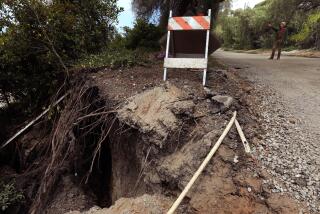A County Comes of Age Amid War : * Civility Allows Strong Emotions, Opinions to Flow
The war in the Gulf has come home to Orange County in sights, sounds and a complex mosaic of emotions.
It has arrived in the somber news for a San Clemente mother of three, who told reporters at a news conference of her late Marine husband’s preparations to meet death and of his commitment to a cause. It has come home at a Jewish rally in Garden Grove, where 8- and 9-year-old children donned gas masks at a booth set up for a rally of 700 people at the Jewish Community Center of Central Orange County to support U.S. troops and Israel. There Rabbi Bernard King said, “There are moments when war becomes a tragic necessity. . . .”
It has come home in the protests at UC Irvine and along the waterfront in Laguna Beach. It has been visible in symbolism--a 90-foot American flag, draped from the rafters of architect Philip Johnson’s magnificent Crystal Cathedral in Garden Grove.
And it has come home in the words of an ex-President, delivering a college speech in Irvine. Former President Gerald R. Ford bluntly called for the removal from power of President Saddam Hussein of Iraq.
It has come home in the cerebral discourse at lecturer Tom Grant’s classes on the Persian Gulf War at UC Irvine. Grant, a lecturer specialist in Third World military conflicts, takes part in a remarkable program that has quickly become a feather in Orange County’s cap--the Global Peace and Conflict Studies Program. A decision made in the early 1980s to build a research facility to promote a deeper understanding of how governments behave in conflict looks wise these days.
It has come home in a debate on the merits of military intervention that took place within the county’s Catholic community of 700,000, a discussion notable for the understanding and tolerance that each side showed for the other’s point of view.
Many bishops across the nation have challenged the Administration’s policy in the Gulf, and the National Conference of Catholic Bishops has been a leader in questioning the moral justification for fighting. The Most Rev. Norman F. McFarland, bishop of Orange, however, distributed a letter to be read two Sundays ago saying that the deployment of military force might “add credibility and effectiveness to the economic and political pressures” on Iraq. He urged local church members to support the effort.
The bishop’s remarks were greeted as “middle-of-the-road” by one Santa Ana war protester. Another, a former priest, said he was relieved that his bishop’s position was “not so single-mindedly right-wing.” And the bishop himself refused to take those who disagreed with him to task, saying wryly that the religious leaders who had spoken out against the war “may have information that I don’t have.”
Orange County has come of age as a place where informed differences of opinion coexist. Of course, some speak with a customary sharp edge. Rep. Robert K. Dornan (R-Garden Grove), says protesters are street people who have nothing else to do, and that students are being stirred up by “their Marxist teachers.”
But the war has demonstrated that Orange County is big enough in 1990 to accommodate both the moderate and the extreme views. In recent weeks, the entire range of emotions has played out in a diverse county. This has been so even as some of our own family members and neighbors have put themselves on the line. And Orange County surely will continue to be center stage on home-front America when a ground campaign begins.
More to Read
Sign up for Essential California
The most important California stories and recommendations in your inbox every morning.
You may occasionally receive promotional content from the Los Angeles Times.





